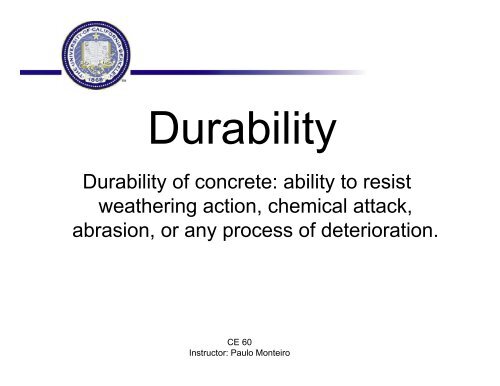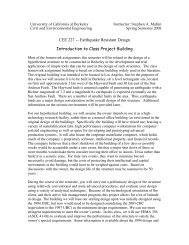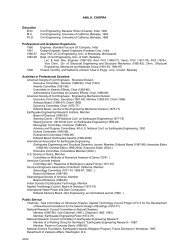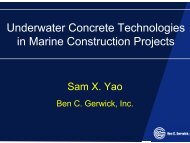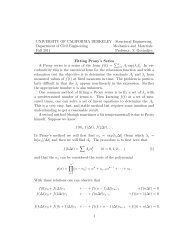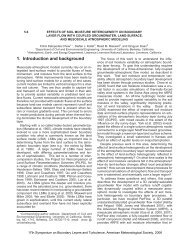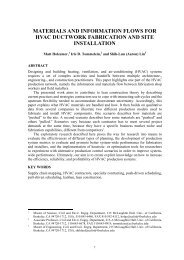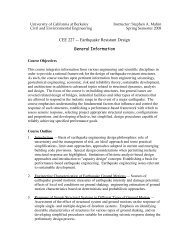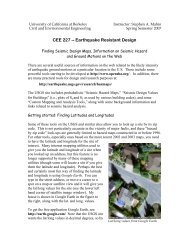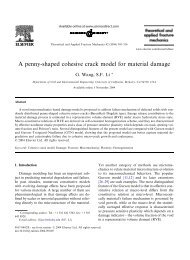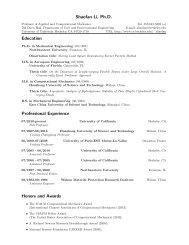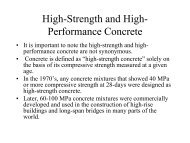Durability of concrete: ability to resist weathering action, chemical ...
Durability of concrete: ability to resist weathering action, chemical ...
Durability of concrete: ability to resist weathering action, chemical ...
Create successful ePaper yourself
Turn your PDF publications into a flip-book with our unique Google optimized e-Paper software.
<strong>Dur<strong>ability</strong></strong><br />
<strong>Dur<strong>ability</strong></strong> <strong>of</strong> <strong>concrete</strong>: <strong>ability</strong> <strong>to</strong> <strong>resist</strong><br />
<strong>weathering</strong> <strong>action</strong>, <strong>chemical</strong> attack,<br />
abrasion, or any process <strong>of</strong> deterioration.<br />
CE 60<br />
Instruc<strong>to</strong>r: Paulo Monteiro
Water<br />
Water Causes:<br />
•Chemical processes <strong>of</strong><br />
degradation<br />
• Physical processes <strong>of</strong><br />
degradation<br />
CE 60<br />
Instruc<strong>to</strong>r: Paulo Monteiro
Water in the Capillary<br />
CE 60<br />
Instruc<strong>to</strong>r: Paulo Monteiro
Perme<strong>ability</strong><br />
• Perme<strong>ability</strong> - the property that governs the rate<br />
<strong>of</strong> flow <strong>of</strong> a fluid in<strong>to</strong> a porous solid.<br />
• Darcy’s law: For steady-state flow, the<br />
coefficient <strong>of</strong> perme<strong>ability</strong>, K, is determined from<br />
Darcy's expression:<br />
dq/dt = K∙(∆H∙A)/(L∙μ)<br />
Where: Dq/dt = rate <strong>of</strong> fluid flow, μ = viscosity <strong>of</strong><br />
the fluid, ∆H = pressure gradient, A = surface<br />
area, and L = thickness <strong>of</strong> the solid.<br />
CE 60<br />
Instruc<strong>to</strong>r: Paulo Monteiro
Perme<strong>ability</strong> <strong>of</strong> Cement Paste<br />
•Age (days) Perme<strong>ability</strong> (cm/s 10 -11 )<br />
•Fresh 20,000,000<br />
•5 4,000<br />
•6 1,000<br />
•8 400<br />
•13 50<br />
•24 10<br />
•ultimate 6<br />
CE 60<br />
Instruc<strong>to</strong>r: Paulo Monteiro
Perme<strong>ability</strong> <strong>of</strong> Cement Paste<br />
•When porosity decreases from 40 <strong>to</strong> 30%,<br />
the perme<strong>ability</strong> drops from 110 <strong>to</strong> 20 x 10 -12<br />
cm/sec.<br />
•However, a decrease in porosity from 30%<br />
<strong>to</strong> 20% results in a small drop in<br />
perme<strong>ability</strong>.<br />
•Reasons:<br />
•Large pores are reduced in size and<br />
number.<br />
•There is creation <strong>of</strong> <strong>to</strong>rtuosity.<br />
CE 60<br />
Instruc<strong>to</strong>r: Paulo Monteiro
Perme<strong>ability</strong> <strong>of</strong> Aggregate<br />
• Compared <strong>to</strong> 30 <strong>to</strong> 40 percent capillary<br />
porosity <strong>of</strong> typical cement pastes in<br />
hardened <strong>concrete</strong>, the volume <strong>of</strong> pores in<br />
most natural aggregates is usually under 3<br />
percent, and it rarely exceeds 10 percent.<br />
• However, the coefficient <strong>of</strong> perme<strong>ability</strong> <strong>of</strong><br />
aggregates are as variable as those <strong>of</strong><br />
hydrated cement pastes <strong>of</strong> water/cement<br />
ratios in the range 0.38 <strong>to</strong> 0.71<br />
CE 60<br />
Instruc<strong>to</strong>r: Paulo Monteiro
Perme<strong>ability</strong> <strong>of</strong> Aggregate<br />
Reason:<br />
• Some aggregates have much higher<br />
perme<strong>ability</strong> than the cement paste<br />
because their capillary pores are much<br />
larger.<br />
• Most <strong>of</strong> the capillary porosity in a mature<br />
cement paste lies in the range 10 <strong>to</strong> 100<br />
nm, while pore size in aggregates are, on<br />
average, larger than 10 microns.<br />
CE 60<br />
Instruc<strong>to</strong>r: Paulo Monteiro
Perme<strong>ability</strong> <strong>of</strong> Aggregates<br />
Type <strong>of</strong> Rock Perme<strong>ability</strong> (cm/sec )<br />
dense trap 2.47 x 10 -12<br />
quartz diorite 8.24 x 10 -12<br />
marble 2.39 x 10 -10<br />
granite 5.35 x 10 -9<br />
sands<strong>to</strong>ne 1.23 x 10 -8<br />
CE 60<br />
Instruc<strong>to</strong>r: Paulo Monteiro
Physical Causes <strong>of</strong> Concrete Deterioration<br />
•1. Deterioration by surface wear.<br />
•Abrasion: dry attrition (wear on<br />
pavements and industrial floors by traffic)<br />
•Erosion: wear produced by abrasive<br />
<strong>action</strong> <strong>of</strong> fluids containing solid particles<br />
in suspension (canal lining, spillways and<br />
pipes).<br />
•Cavitation: loss <strong>of</strong> mass by formation <strong>of</strong><br />
vapor bubbles and their subsequent<br />
collapse.<br />
CE 60<br />
Instruc<strong>to</strong>r: Paulo Monteiro
Physical Causes <strong>of</strong> Concrete Deterioration<br />
Abrasion - Erosion<br />
•The deterioration starts at the surface,<br />
therefore special attentions should be given<br />
<strong>to</strong> quality <strong>of</strong> the <strong>concrete</strong> surface.<br />
•Avoid laitance (layer <strong>of</strong> fines from cement<br />
and aggregate).<br />
CE 60<br />
Instruc<strong>to</strong>r: Paulo Monteiro
Physical Causes <strong>of</strong> Concrete Deterioration<br />
3. Deterioration by Frost Action<br />
•When water freezes, there is an expansion <strong>of</strong> 9%.<br />
However, some <strong>of</strong> the water may migrate through<br />
the boundary, decreasing the hydraulic pressure.<br />
•Hydraulic pressure depends on:<br />
•Rate at which ice is formed.<br />
•Perme<strong>ability</strong> <strong>of</strong> the material.<br />
•Distance <strong>to</strong> an "escape boundary."<br />
CE 60<br />
Instruc<strong>to</strong>r: Paulo Monteiro
3. Deterioration by Frost Action<br />
Problem:<br />
The transformation <strong>of</strong> ice from<br />
liquid water generates a<br />
volumetric dilation <strong>of</strong> 9%. If<br />
the transformation occurs in<br />
small capillary pores, the ice<br />
crystals can damage the<br />
cement paste by pushing the<br />
capillary walls and by<br />
generating hydraulic pressure.<br />
CE 60<br />
Instruc<strong>to</strong>r: Paulo Monteiro<br />
Mehta and Monteiro: Concrete
3. Deterioration by Frost Action<br />
Solution:<br />
Air voids can provide an<br />
effective escape boundary<br />
<strong>to</strong> reduce this pressure.<br />
CE 60<br />
Instruc<strong>to</strong>r: Paulo Monteiro
3. Deterioration by Frost Action<br />
Air-Entraining<br />
CE 60<br />
Instruc<strong>to</strong>r: Paulo Monteiro<br />
Mehta and Monteiro: Concrete
This image cannot currently be displayed.<br />
Freezing <strong>of</strong> Concrete<br />
CE 60<br />
Instruc<strong>to</strong>r: Paulo Monteiro
This image cannot currently be displayed.<br />
Freezing <strong>of</strong> Concrete<br />
Does <strong>concrete</strong> freezing<br />
cause the air-entrained<br />
bubbles <strong>to</strong> get larger or<br />
smaller<br />
Answer: Smaller. Since<br />
the paste is expanded, the<br />
air-voids are compressed.<br />
Mehta and Monteiro: Concrete<br />
CE 60<br />
Instruc<strong>to</strong>r: Paulo Monteiro
Frost Action on Aggregate<br />
•Aggregates likelihood <strong>to</strong> cause freezing damage depends on<br />
pore:<br />
•Sizes<br />
•Number<br />
•Continuity<br />
•3 classes <strong>of</strong> aggregate<br />
•(1) Low perme<strong>ability</strong> and high strength: No problem! The rock is strong<br />
enough <strong>to</strong> support the hydraulic pressure.<br />
•(2) Intermediate perme<strong>ability</strong>: Potential depending on (a) rate <strong>of</strong><br />
temperature drop. (b) distance the water must travel <strong>to</strong> find an escape<br />
boundary – Critical Aggregate Size (a large aggregate may cause<br />
damage but smaller particles won't).<br />
•(3) High perme<strong>ability</strong>: May cause problem with the transition zone.<br />
CE 60<br />
Instruc<strong>to</strong>r: Paulo Monteiro
Fac<strong>to</strong>rs Controlling Frost Resistance <strong>of</strong> Concrete<br />
MSA (in) air content (%)<br />
3/8<br />
1/2<br />
3/4<br />
1<br />
2<br />
3<br />
7.5<br />
7<br />
6<br />
6<br />
5<br />
4.5<br />
CE 60<br />
Instruc<strong>to</strong>r: Paulo Monteiro
Deterioration by Fire<br />
•Concrete is able <strong>to</strong> retain sufficient strength<br />
for a reasonably long time.<br />
CE 60<br />
Instruc<strong>to</strong>r: Paulo Monteiro
Consequence<br />
CE 60<br />
Instruc<strong>to</strong>r: Paulo Monteiro
Fire in the Chunnel<br />
CE 60<br />
Instruc<strong>to</strong>r: Paulo Monteiro
Effect <strong>of</strong> High Temperature<br />
•Effect <strong>of</strong> High Temperature on Cement Paste<br />
•Depends on:<br />
•Degree <strong>of</strong> hydration<br />
•Moisture state<br />
•Causes de-hydration:<br />
•Ettringite > 100 C<br />
•Ca(OH) 2 500-600 C<br />
•CSH ~ 900 C<br />
•Effect <strong>of</strong> High Temperature on Aggregate<br />
•Siliceous quartz: 573 C --sudden volume<br />
change ( quartz)<br />
•Carbonate: MgCO3 > 700 C, CaCO3 > 900 C<br />
CE 60<br />
Instruc<strong>to</strong>r: Paulo Monteiro
Corrosion <strong>of</strong> Reinforced Concrete<br />
CE 60<br />
Instruc<strong>to</strong>r: Paulo Monteiro
Electro<strong>chemical</strong> Process <strong>of</strong> Steel Corrosion in Concrete<br />
CE 60<br />
Instruc<strong>to</strong>r: Paulo Monteiro
Volumetric Change
Carbonation <strong>of</strong> Concrete<br />
Painting with Phenolphthalein<br />
Concrete exposed <strong>to</strong> CO 2<br />
(accelerated test)<br />
CE 60<br />
Instruc<strong>to</strong>r: Paulo Monteiro<br />
Carbonated <strong>concrete</strong>
Alkali-Silica Re<strong>action</strong><br />
CE 60<br />
Instruc<strong>to</strong>r: Paulo Monteiro
ASR Chemistry<br />
1) The high pH in the cement paste promotes the<br />
hydrolysis <strong>of</strong> silica:<br />
Si-O-Si + H OH Si-OH + Si-OH<br />
aggregate paste<br />
2) Si-OH react with the paste <strong>to</strong> form Si-O-<br />
3) Si-O-, adsorbs Na, K, and Ca <strong>to</strong> form a gel.<br />
CE 60<br />
Instruc<strong>to</strong>r: Paulo Monteiro
ASR Optical Image<br />
CE 60<br />
Instruc<strong>to</strong>r: Paulo Monteiro
ASR Optical Image<br />
CE 60<br />
Instruc<strong>to</strong>r: Paulo Monteiro
Repairing ASR Damage <strong>to</strong> a Concrete<br />
Dam<br />
Typical Options:<br />
Moni<strong>to</strong>ring<br />
Slot cut<br />
Upstream face membrane<br />
Roller compacted <strong>concrete</strong><br />
Decrease the reservoir<br />
Dam Removal<br />
CE 60<br />
Instruc<strong>to</strong>r: Paulo Monteiro<br />
Mehta and Monteiro: Concrete
ASR Damage Examples<br />
Built in 1965, this deteriorated bridge is located 9.7 miles west <strong>of</strong> Lee<br />
Vining at 9400 feet elevation on the eastern slope <strong>of</strong> the Sierra Nevada.<br />
CE 60<br />
Instruc<strong>to</strong>r: Paulo Monteiro<br />
Mehta and Monteiro: Concrete
ASR Damage Examples<br />
Airfield parking apron at Naval Air Station Point Mugu, California .<br />
courtesy <strong>of</strong> U.S. Navy, NFESC<br />
CE 60<br />
Instruc<strong>to</strong>r: Paulo Monteiro<br />
Mehta and Monteiro: Concrete
Sulfate Attack<br />
Importance<br />
• Sulfate attack on <strong>concrete</strong> has been reported<br />
from many other parts <strong>of</strong> the world.<br />
• As early as 1936 the <strong>concrete</strong> construction<br />
manual published by the U. S. Bureau <strong>of</strong><br />
Reclamation warned that concentrations <strong>of</strong><br />
soluble sulfates greater than 0.1 percent in soil<br />
may have a deleterious effect on <strong>concrete</strong>, and<br />
more than 0.5 percent soluble sulfate in soil may<br />
have a serious effect.<br />
CE 60<br />
Instruc<strong>to</strong>r: Paulo Monteiro
Sulfate Attack<br />
Origin <strong>of</strong> the problem<br />
• Most soils contain some sulfate in the form <strong>of</strong> gypsum<br />
(typically 0.01 <strong>to</strong> 0.05 percent expressed as SO 4 ); this<br />
amount is harmless <strong>to</strong> <strong>concrete</strong>.<br />
• Higher concentrations <strong>of</strong> sulfate in groundwaters are<br />
generally due <strong>to</strong> the presence <strong>of</strong> magnesium and<br />
alkali sulfates.<br />
• Ammonium sulfate is frequently present in agricultural<br />
soil and water. Effluents from furnaces that use highsulfur<br />
fuels and from the <strong>chemical</strong> industry may<br />
contain sulfuric acid.<br />
CE 60<br />
Instruc<strong>to</strong>r: Paulo Monteiro
Expansion <strong>of</strong> Concrete<br />
• When <strong>concrete</strong> cracks, its perme<strong>ability</strong><br />
increases and the aggressive water<br />
penetrates more easily in<strong>to</strong> the interior,<br />
thus accelerating the process <strong>of</strong><br />
deterioration.<br />
• Sometimes, the expansion <strong>of</strong> <strong>concrete</strong><br />
causes serious structural problems.<br />
CE 60<br />
Instruc<strong>to</strong>r: Paulo Monteiro
Loss <strong>of</strong> Strength and Mass<br />
•Sulfate attack can also take the<br />
form <strong>of</strong> a progressive loss <strong>of</strong><br />
strength and loss <strong>of</strong> mass due <strong>to</strong><br />
loss <strong>of</strong> cohesiveness in the cement<br />
hydration products.<br />
CE 60<br />
Instruc<strong>to</strong>r: Paulo Monteiro
Expansive Re<strong>action</strong><br />
• C 3 A + 3C$H 2 + 26H C 3 A∙3C$∙32H (ettringite)<br />
In the presence <strong>of</strong> sulfates<br />
C 3 A·C$·18H (monosulfate)<br />
CE 60<br />
Instruc<strong>to</strong>r: Paulo Monteiro<br />
Mehta and Monteiro: Concrete
Sulfate Attack<br />
• Gypsum formation leads <strong>to</strong> reduction <strong>of</strong><br />
stiffness and strength, then by<br />
expansion and cracking.<br />
CE 60<br />
Instruc<strong>to</strong>r: Paulo Monteiro
Sodium Sulfate Attack<br />
• Na 2 SO 4 +Ca(OH) 2 +2H 2 O <br />
CaSO 4 ∙2H 2 O + 2NaOH<br />
• The formation <strong>of</strong> sodium hydroxide as a byproduct<br />
<strong>of</strong> the re<strong>action</strong> ensures the continuation<br />
<strong>of</strong> high alkalinity in the system, which is essential<br />
for the st<strong>ability</strong> <strong>of</strong> the cementitious material<br />
C-S-H.<br />
CE 60<br />
Instruc<strong>to</strong>r: Paulo Monteiro
Magnesium Sulfate Attack<br />
• MgSO 4 +Ca(OH) 2 +2H 2 O <br />
CaSO 4 ∙2H 2 O + Mg(OH) 2<br />
• 3MgSO 4 + 3CaO∙2SiO 2 ∙3H 2 O + 8H 2 O<br />
3CaSO 4 ∙2H 2 O + 3Mg(OH) 2 + 2SiO 2 ∙H 2 O<br />
• The conversion <strong>of</strong> calcium hydroxide <strong>to</strong> gypsum is<br />
accompanied by the simultaneous formation <strong>of</strong><br />
relatively insoluble magnesium hydroxide.<br />
• In the absence <strong>of</strong> hydroxyl ions in the solution C-S-H<br />
is no longer stable and is also attacked by the sulfate<br />
solution.<br />
• The magnesium sulfate attack is, therefore, more<br />
severe on <strong>concrete</strong>.<br />
CE 60<br />
Instruc<strong>to</strong>r: Paulo Monteiro
Fac<strong>to</strong>rs Influencing Sulfate Attack<br />
• Amount and nature <strong>of</strong> the sulfate present<br />
• Level <strong>of</strong> the water table and its seasonal<br />
variation<br />
• Flow <strong>of</strong> groundwater and soil porosity<br />
• Form <strong>of</strong> construction<br />
• Quality <strong>of</strong> <strong>concrete</strong><br />
CE 60<br />
Instruc<strong>to</strong>r: Paulo Monteiro
ACI Building Code 318<br />
• Negligible attack: When the sulfate content is<br />
under 0.1 percent in soil, or under 150 ppm<br />
(mg/liter) in water, there shall be no restriction<br />
on the cement type and water/cement ratio.<br />
• Moderate attack: When the sulfate content is<br />
0.1 <strong>to</strong> 0.2 percent in soil, or 150 <strong>to</strong> 1500 ppm in<br />
water, ASTM Type II portland cement or<br />
portland pozzolan or portland slag cement shall<br />
be used, with less than an 0.5 water/cement<br />
ratio for normal-weight <strong>concrete</strong>.<br />
CE 60<br />
Instruc<strong>to</strong>r: Paulo Monteiro
ACI Building Code 318<br />
• Severe attack: When the sulfate content is 0.2<br />
<strong>to</strong> 2.00 percent in soil, or 1500 <strong>to</strong> 10,000 ppm in<br />
water, ASTM Type V portland cement, with less<br />
than an 0.45 water/cement ratio, shall be used.<br />
• Very severe attack: When the sulfate content is<br />
over 2 percent in soil, or over 10,000 ppm in<br />
water, ASTM Type V cement plus a pozzolanic<br />
admixture shall be used, with less than an 0.45<br />
water/cement ratio.<br />
CE 60<br />
Instruc<strong>to</strong>r: Paulo Monteiro


